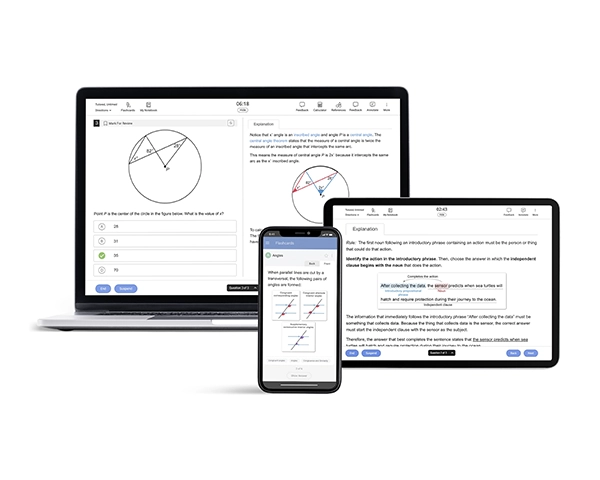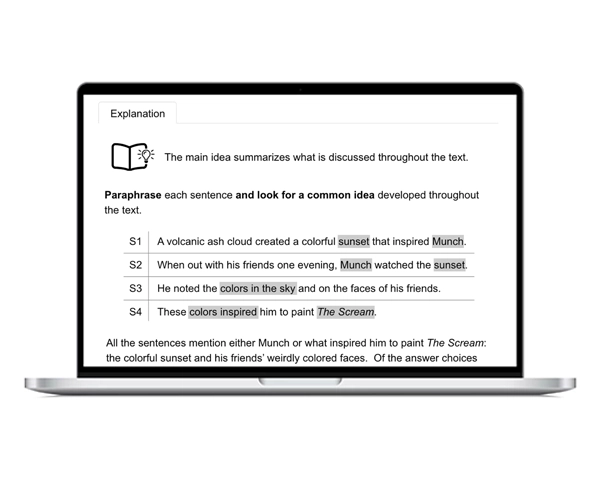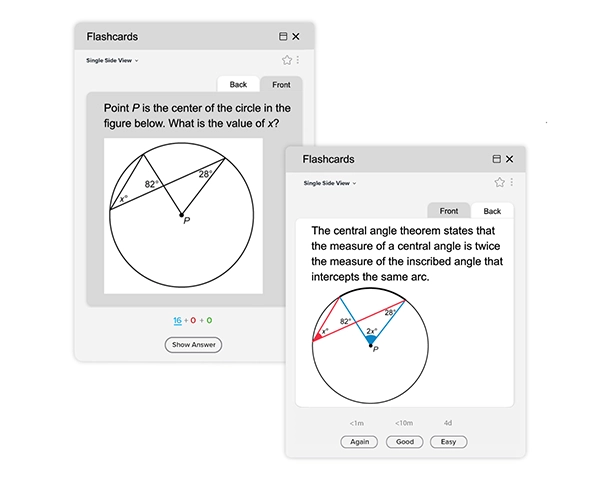(New) Digital SAT® Test Format
Time Duration, Question Types, and Section Structure

How Is the Digital SAT Structured?
Unlike the paper-and-pencil SAT, which had three uniform sections, the Digital SAT comes in an adaptive modular format and includes two sections: Reading and Writing, and Math. The total duration of the test is 2 hours and 14 minutes.
But before we walk you through the Digital SAT format, let's review a few questions commonly asked by test-takers.
What types of questions are on the Digital SAT vs. the SAT?
The Digital SAT Reading and Writing section consists of 54 multiple-choice questions (MCQs) paired with a short reading passage. This is a big departure from the previous SAT Reading section format, which featured four long passages with several MCQs.
The Digital Math section includes both multiple-choice and student-produced response (SPR) questions, much like the previous SAT Math section. The math skills tested on the Digital SAT are more applicable to what students will need in college. While students could use a calculator on only some questions in the SAT Math section, students can use the built-in calculator or an approved calculator throughout the entire Digital SAT Math section.
How many questions are on the Digital SAT?
The Digital SAT consists of 98 questions in total, including MCQs and SPRs. There are 54 questions in the Reading and Writing section and 44 in the Math section.
The table below shows the number of questions per module and the time allotted.
| Reading and Writing (RW) | Math | |||
|---|---|---|---|---|
| Number of Questions | Time | Number of Questions | Time | |
| Module 1 | 27 | 32 mins | 22 | 35 mins |
| Module 2 | 27 | 32 mins | 22 | 35 mins |
| Total | 54 | 64 mins | 44 | 70 mins |
Each section of the new Digital SAT will have an equal number of questions spread across two modules. These questions will be randomly pulled from the SAT database and include a mix of easy, medium, and hard difficulty levels. Depending on your performance in the first module, the SAT testing app will decide the difficulty level generated in the second module.
With the basic structure of the Digital SAT explained, let’s learn more about each section.

Digital SAT - Reading and Writing Section
Reading and Writing is the first section you’ll encounter on the Digital SAT. Each module in this section consists of 27 questions and lasts 32 minutes. These 27 questions include 25 operational and two pretest questions, which will not count towards the final score. They will not be labeled separately, so treat each question equally.
Each multiple-choice question will accompany a passage that is no more than 150 words long. These passages will draw from various styles and sources, including short poems, graphs, charts, tables, and bulleted lists.
The Reading and Writing section will assess your college readiness in English language literacy and content knowledge based on four key domains:
Craft and Structure (Approx. 13 - 15 questions)
This domain will assess a range of skills, including your understanding of high-utility words, the ability to evaluate texts rhetorically, and the ability to connect texts topically. It will measure your proficiency in comprehension, vocabulary, analysis, synthesis, and reasoning.
-
Information and Ideas (Approx. 12 - 14 questions)
This domain will evaluate your comprehension, analysis, and reasoning skills, as well as your ability to locate, interpret, analyze, and integrate information from texts and graphics.
-
Standard English Conventions (Approx. 11 - 15 questions)
This domain will assess your editing skills in a way that aligns texts with the core conventions of Standard English sentence structure, usage, and punctuation.
-
Expression of Ideas (Approx. 8 - 12 questions)
This domain focuses on measuring your ability to improve written expressions to achieve specific rhetorical goals. It assesses how effectively you can enhance the impact of a text through thoughtful improvements and refinements.

Digital SAT - Math Section
The Math section is designed to measure your college readiness in mathematical skills. It focuses on key elements of algebra, advanced math, problem-solving and data analysis, geometry, and trigonometry. The total time allotted for this section is 70 minutes.
Per the College Board®, around 75% of the questions in this section will be MCQs, while 25% will consist of SPRs. The following table shows the distribution of MCQs and SPRs in the Math section of the digital SAT:
| Digital SAT Math Section | ||
|---|---|---|
| Module 1 | Module 2 | |
| No. of Questions | 22 | 22 |
| Time | 35 mins | 35 mins |
| Calculator Usage | Yes | |
| Approx. no. of MCQs | 33 | |
| Approx. no. of SPRs | 11 | |
This section will test you on the following four key domains:
-
Algebra (Approx. 13 - 15 questions)
This domain is designed to evaluate your proficiency in solving linear equations in one and two variables, linear functions, systems of two linear equations in two variables, and linear inequalities in one or two variables.
-
Advanced Math (Approx. 13 - 15 questions)
This domain assesses your ability to solve equivalent expressions, nonlinear equations in one variable and systems of equations in two variables, and nonlinear functions.
-
Problem-Solving and Data Analysis (Approx. 5 - 7 questions)
This domain assesses your understanding of several key mathematical concepts. It includes your knowledge of ratios, rates, and proportional relationships, as well as your ability to work with units and percentages. You will also be tested on one-variable data, focusing on distributions and measures of center and spread, and two-variable data, including models and scatterplots. Additionally, the domain covers probability and conditional probability, along with inference from sample statistics, margin of error, and the evaluation of statistical claims in observational studies and experiments.
-
Geometry and Trigonometry (Approx. 5 - 7 questions)
This domain is designed to evaluate your proficiency in area, volume, lines, angles, and triangles. It also assesses your knowledge of right triangles, trigonometry, and circles.
Out of these four topics, algebra has the highest number of questions on the test and is considered the most important. Prepare and practice for the Digital SAT with UWorld’s Digital SAT Practice Test at an affordable price and achieve your dream score!
Remember that questions from all four content domains will be spread across the 33 MCQs and 11 SPRs. Each module will include two pretest questions, which will not be labeled separately. As such, make sure to treat each question equally.

How Is Each Section Scored on the Digital SAT?
Like the paper-and-pencil SAT, the Digital SAT exam will be scored on a scale of 400–1600. This includes the section scores for Reading and Writing, as well as Math. You can learn more about how the Digital SAT is scored in our Digital SAT scoring guide.
Do you want to learn more about the test syllabus and question types on the digital SAT? We’re here to help! Check out our Digital SAT Syllabus to get a thorough understanding of what topics you need to focus on for your upcoming test!
References
- What’s on the SAT? – SAT Suite | College Board. (n.d.).
https://satsuite.collegeboard.org/sat/whats-on-the-test - How Long Does the SAT Take? (2023, March 7). College Board Blog.
https://blog.collegeboard.org/how-long-does-the-sat-take - Scoring New SAT Practice Test 1 | SAT Suite of Assessments – The College Board. (n.d.). satsuite.collegeboard.org. Retrieved 2023, from
https://satsuite.collegeboard.org/media/pdf/scoring-sat-practice-test-1.pdf - The Digital SAT® Suite of Assessments Specifications Overview. (n.d.). satsuite.collegeboard.org. Retrieved 2023, from
https://satsuite.collegeboard.org/media/pdf/digital-sat-test-spec-overview.pdf - Digital SAT Sample Questions and Explanations. (n.d.). satsuite.collegeboard.org. Retrieved 2023, from
https://satsuite.collegeboard.org/media/pdf/digital-sat-sample-questions.pdf - International Students: College Board Answers Your Questions About the Digital SAT. (2022, May 2).
https://blog.collegeboard.org/international-students-college-board-answers-your-questions-about-digital-sat
Frequently Asked Questions (FAQs)
Is the SAT a pen-and-paper test or computer-based?
Is the Digital SAT all multiple-choice?
Is the Essay section required for the Digital SAT?
Is there a penalty for incorrect answers?
Read More About the Digital SAT
Considering taking the Digital SAT and wondering what it entails? This guide provides all the essential information about the Digital SAT, including the test's significance and effective strategies for achieving a high score.
Interested in knowing how the Digital SAT is scored? This guide will provide a complete breakdown of the Digital SAT scoring guidelines. Read on to know everything about the score ranges and the test score reports.
Have you started preparing for the Digital SAT? This roadmap will take you through a complete guide of the Digital SAT syllabus, the types of questions you’ll encounter, and the weightage given to its different topics.
Ready to study for the Digital SAT but don’t know where to start? Prepare the right way! Here is a guidebook to help you efficiently prepare for your Digital SAT and get your dream score.